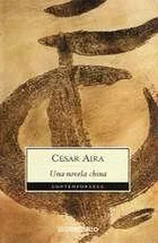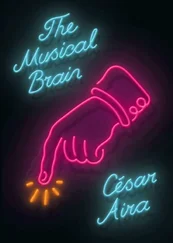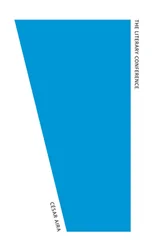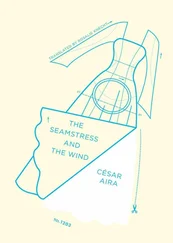An idea was dawning on him, and its phases were cascading toward him. In reality, nobody was rushing him, but he had been thrust upon time. He wondered if he’d have enough space. When he turned his eyes away from the patient’s, where they’d been glued, he felt as if he’d lost some of his strength. Even so, out of inertia, he kept figuring things out. To his right, on the wall facing the street, was a large French door covered with a thick, dark-red velvet curtain. He went over to it and pulled on the cord, which opened the panels sideways. There was a balcony. He didn’t go out (he was afraid they’d think he was going to jump), but he glanced up. Right in front, between two tall building, he could see a strip of star-studded sky. He returned to the bed, leaving the door open. In the room the cold night air began to be felt, but nobody objected. He looked back into the patient’s eyes to recharge his batteries. He needed all his strength for what he was planning to attempt.
It was an old idea, which had remained latent in the depths of his mind all the years he had devoted to the Miracle Cures. He had never kept files with a strict chronology, and his papers had gotten mixed up again and again, a thousand times (his ideas were annotations on his ideas), so he couldn’t be absolutely certain, but he had the impression that it had been his first idea, the original Miracle Cure. In that case, and in accordance with the law of Decreasing Output, it was his best. It was based on the following, if somewhat simplified, reasoning:
A miracle, in the event that one occurred, should mobilize all possible worlds, for there could not be a rupture in the chain of events in reality without the establishment of another chain, and with it a different totality. As long as the operation dealt with alternative worlds, however, it would be an impractical fantasy. As far as facts were concerned, there was only one world, and that was where the insurmountable veto against miracles arose. And the truth is, there were no miracles, as anybody with a little common sense could ascertain. Someone like Dr. Aira, who didn’t even believe in God, could not entertain the least shadow of a doubt in that regard. Just because there had not yet been any miracles, however, didn’t mean they couldn’t happen; superstition, ignorance, gullibility all led one to think that miracles could happen just like that, naturally. On the other hand, it was possible to produce one, create one as an artifact, or better yet, as a work of art. For this, one only needed to introduce the dimension of human time, which was not difficult because time participated, by its very heft, in all human activities, and even more so in those activities that entailed almost superhuman efforts and difficulties. In practical, everyday terms, time is constantly producing a mutation of the world. After one minute, even a hundredth of a second, the world is already different, though not different in the catalogue of possible worlds but rather a different possible-real one, which is the same, because it has the same degree of reality. And “the same” is equivalent to “the only.” It was within this transformational One, otherwise known as “the real,” that Dr. Aira’s idea for the production of miracles functioned.
Under these conditions, a miracle was simply impossible. But it could be created indirectly, through negation, by excluding from the world everything that was incongruent with it occurring. If one wanted a dog to fly, all one had to do was separate out each and every fact, without exception, that was incompatible with a flying dog. However, which facts were these? Here was the key to the whole thing: to make a correct and exhaustive selection. A wide field had to be covered: nothing less than the totality of the Universe. There were no pre-established or thematic or formal limits; the reach of the “compatible” was, precisely, total. The most far-flung fact or quality — or constellation of the two — could form part of the great figuration within which Miracles could or could not take place. Nor were levels a factor, for the line might run up and down (or to the sides) through all of them. The trick was to put into play the greatest of all Encyclopedias and to compile the relevant list from that. Who could do that? The customary response, the one that had been offered since oldest antiquity was: God. And to remain with that meant Miracles would have stayed within his jurisdiction. Dr. Aira’s originality was in postulating that man could do it, too. It had occurred to him once while listening to the casual reflections of his friend Alfredo Prior, the painter. Speaking about paintings (perhaps Picasso’s or Rembrandt’s), Alfredito had said, “No masterpiece is completely perfect, there’s always a slipup, an error, something sloppy.” This might have been a factual observation, but it was also a profound truth that Dr. Aira treasured. Human acts not only contained imperfections but required them as the starting point in their search for efficacy. Discouragement in the matter of Miracles came from not recognizing this. If, on the other hand, this deficiency were accepted, creating a miracle would be as easy (and as difficult) as creating an artistic masterpiece. One simply had to give oneself time. God could revise the entire Encyclopedia and make all the right selections in an instant; man needed time (let’s say, an hour), and he needed to allow himself a margin of error in the selections, trusting that they would not be critical errors. After all, that mechanism had an antecedent in the daily functioning of individuals: attention, which also compartmentalized the world, but which, in spite of frequent errors, achieved a level of efficacy necessary for its bearer to survive, and even prosper.
That’s as far as the idea had come, and it was enough. The entire deduction of the reality of Miracles was there. Still pending was the elaboration of the historical aspect of the question (but this would be left for the installments), that is to say, why, in light of these discoveries, certain periods of history and modes of production were rife with miracles, and others had none.
Also left hanging, until now, was the practical aspect per se, that is, how to do it once it had been proven to be possible. When the theory is solid, the practice comes on its own. He simply had to dig in, and if he hadn’t done so before now it was because he hadn’t had the opportunity. Now the moment had arrived, and it was futile for him to reproach himself for having left the delicate question of the practice, in its entirety, to be improvised at the scene of events, especially considering the long stretches of free time he’d had over the years; because experience had taught him that practice couldn’t be thought about like theory, or if it was, its nature changed, it became theory, and practice itself remained un-thought about. It was futile to have regrets, above all because he was already seeing the solution arrive on time for its appointment, and although it was very complicated, it appeared to him all at once, in an avalanche whose movement he knew well. Like a philosophical handyman, he carried ideas and fragments of ideas from other fields around in his head, and the way they instantaneously adapted to his needs elated him, as if all his problems had come to an end.
The operational tool came from the field of publishing. It was the “foldout” we’ve already mentioned, which had figured on his list of luxurious and unrealizable fantasies for his installments. Here the page foldout turned into the form of a foldout screen, with indefinite though not unlimited panels. Using the “foldout screen format” he could quickly and easily compartmentalize the Universe: thin and made of a very fine plastic film with wire stays, the screen could pass between two contiguous elements that were almost touching; flexible, it could make all the turns necessary; and its ability to continue to unfold made it possible to connect the most remote points as well as the closest one, and to divide up immense as well as tiny areas. All he had to do was pull the panels, this way and that, excluding areas of reality that were incompatible with the survival of this man. In other words: the Universe was now a single room, and the direct and indirect causes of his inevitable death were flocking indiscriminately toward the sickbed. All he had to do was raise the screen and stop them in their tracks. It was doable because these causes did not include everything that constituted reality, only a small part — well chosen, that’s true — of the totality, which is why no sector could be excluded a priori. Once a “security zone” had been configured, the patient would rise from his bed, cured and happy, ready to live another thirty years. In the “open” world, such as it was now, he couldn’t live; all the factors contributing to this impossibility had to remain on the other side of the screen. Or better said: not all, because that would be to fall once again into the divinity requirement; “all” that were humanly possible to find and isolate, those necessary to obtain the desired result, which, after all was said and done, was fairly modest: an individual cure.
Читать дальше












